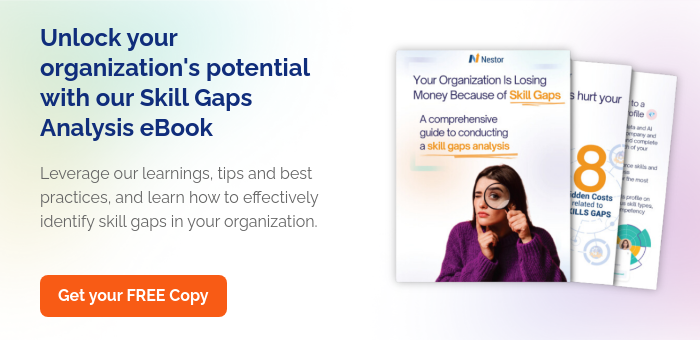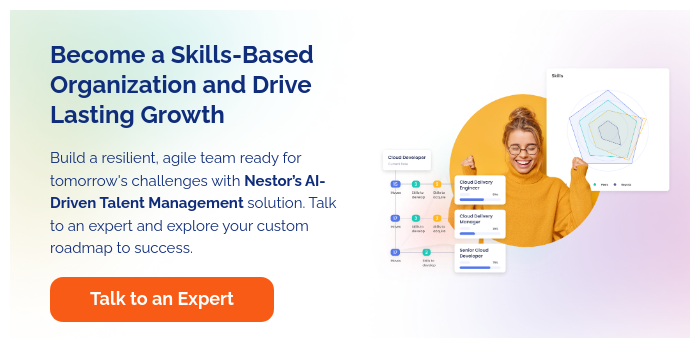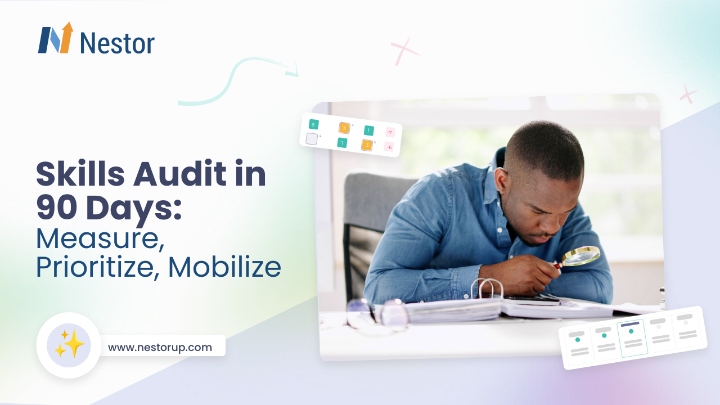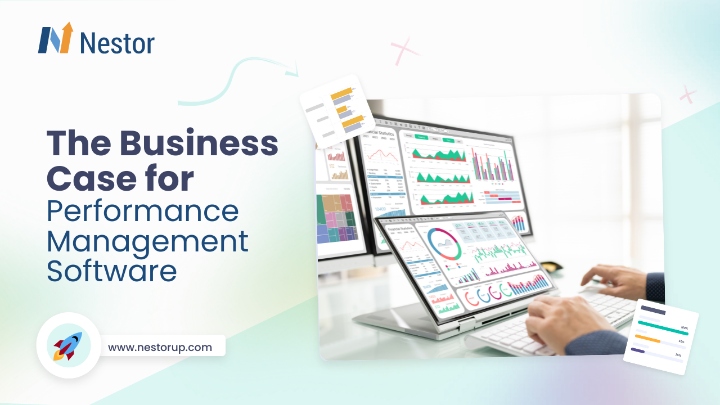Close the Skills Gap – The Ultimate Guide [FREE Template and eBook]
22 min read
![Close the Skills Gap - The Ultimate Guide [FREE Template and eBook]](https://d2gqsl2uwdd3c7.cloudfront.net/wp-content/uploads/2023/05/Close-the-Skills-Gap-The-Ultimate-Guide-FREE-Template-and-eBook.png)
Contents
In today’s rapidly changing workforce, to close the skills gap has become crucial for staying competitive. HR leaders need actionable strategies and tools to address this challenge effectively. That’s why we’ve created this ultimate guide, packed with practical insights and free resources to help you start closing the skills gap today.
In this guide, you will find:
- Free Skills Gap Analysis Template – A ready-to-use tool to identify and address skills gaps quickly.
- Skill Gap Analysis eBook – An in-depth resource offering comprehensive strategies for developing your workforce.
- Skills Gap Flowchart – A step-by-step visual guide to help you determine the best path to address skill deficiencies.
If skill-building doesn’t catch up with the rate of technological progress, the G20 economies could lose up to $11.5 trillion in cumulative GDP growth in the next 10 years.
— Accenture
Closing the Skills Gap: A Key Concern
Closing the skills gap is now a pressing issue in today’s job market. Businesses of all sizes struggle to find candidates with the right skills for critical roles. This problem slows down growth and negatively impacts productivity, innovation, and competitiveness.
As a matter of fact, recent data shows that 83% of HR leaders have trouble recruiting suitable candidates in the last 12 months. Additionaly, attribute this to a skills shortage.
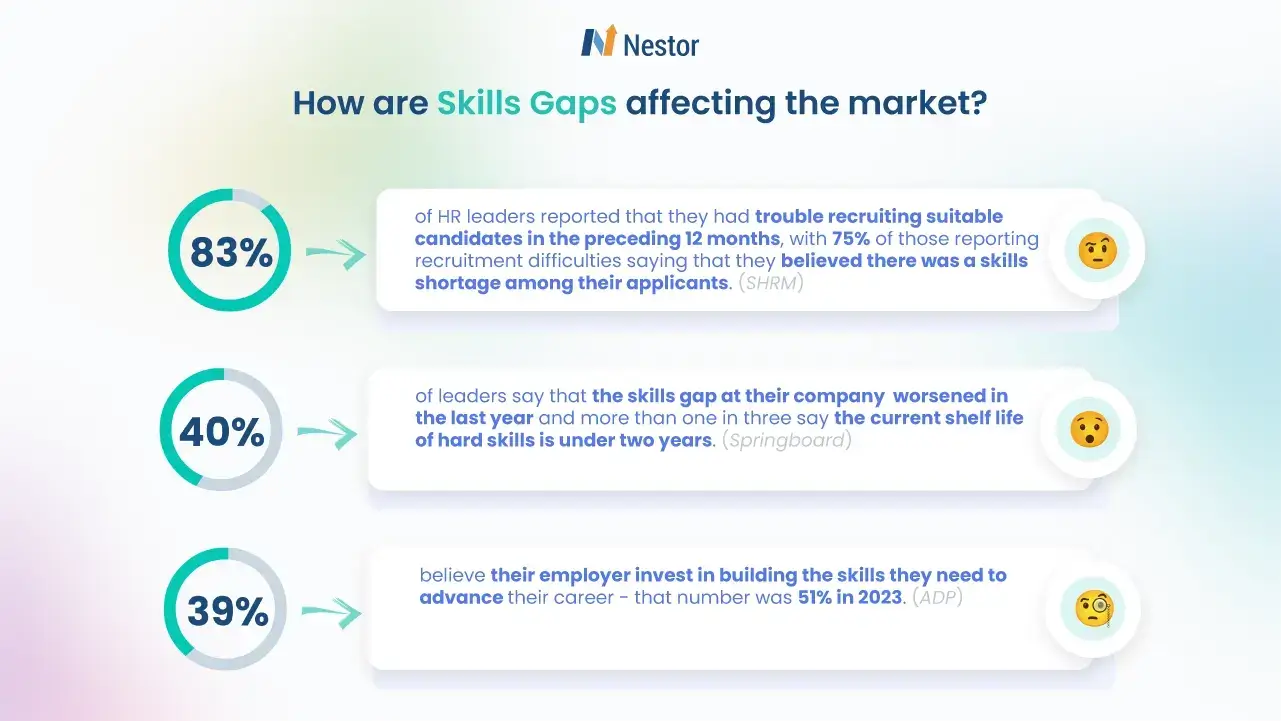
Addressing the skills gap is not only HR’s job. However, many people look to HR for effective solutions to the shortage of key skills and knowledge.
Understanding Skills Gaps
Understanding skills gaps is essential for developing effective strategies to close them. These gaps do not appear suddenly. They often result from a mix of factors, including rapid technology changes, evolving business models, and shifts in the global economy. In addition, lack of visibility over internal skills can also play a role.
This article aims to equip HR and business leaders with strategies to tackle existing and upcoming skill gaps. We will explore various actionable approaches, from recruitment and training to internal mobility and partnerships with educational institutions.
What Are Skills Gaps?
Skills gaps are the mismatches between what employers need and what workers can do. Thus, they create real problems for both companies and employees, causing frustration and missed opportunities.
According to Springboard’s latest State of the Workforce skill gaps have worsened in the past year. Correspondingly, more than a third of leaders say the lifespan of hard skills is now under two years.
Here’s what skill gaps often look like:
- Tech skills: New tools and software come out all the time. Workers may struggle to learn them quickly enough.
- People skills: Many job seekers lack essential soft skills like communication and creative problem-solving. These skills are crucial in most workplaces but are often overlooked in formal education.
- Industry knowledge: Experienced workers can fall behind if they don’t keep learning, especially in fast-changing fields like healthcare, finance, or renewable energy.
- Leadership abilities: As companies grow, they need leaders who can manage complex situations. Good leaders must think strategically, understand emotions, and motivate others.
- Critical thinking: In a world full of information, the ability to analyze and make sound decisions is essential. Many employees struggle with this skill.
Understanding the Skills Gap
Skills gaps are not static; they change as the workplace evolves. New technologies, economic shifts, and changing customer needs all contribute. These gaps can appear anywhere, from new hires to top managers.
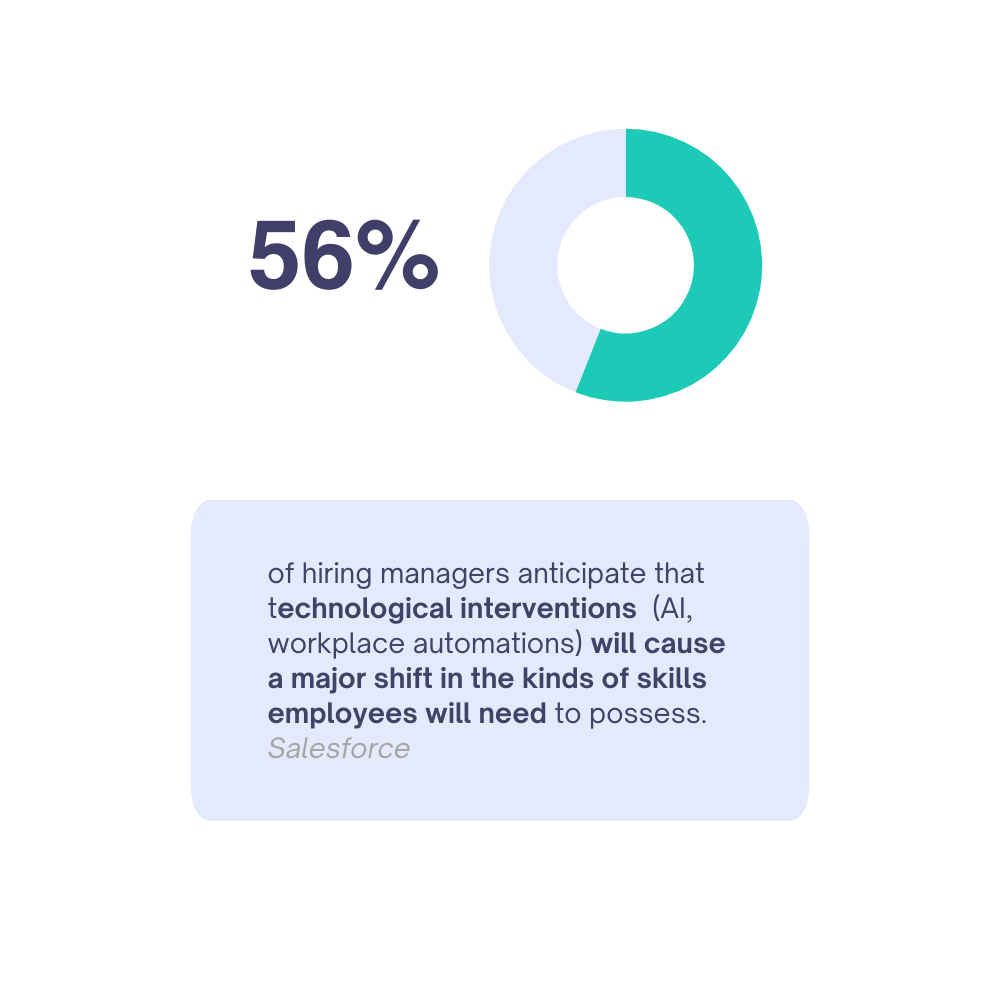
Furthermore, according to Salesforce, 56% of hiring managers expect disruptions due to technological advancements. AI and automation are shifting the skills employees need. This emphasizes the need for upskilling and reskilling efforts.
Hence, understanding skills gaps helps both employers and workers. Companies can plan better training, while workers can focus on learning essential skills. The goal is to ensure employees have the right abilities to excel in their jobs and grow in their careers.
What Causes Skills Gaps?
Identifying the root causes of skills gaps is crucial for addressing them. Here are key factors contributing to this issue:
- Rapid technological advancement: Technology evolves quickly. Ass a result, many workers struggle to keep up with new tools and systems, especially in areas like AI and data analysis.
- Changing business models: As companies adapt to new market demands, the skills they require may shift. For instance, focusing on online sales may require different skills than in-person sales.
- Educational misalignment: School doesn’t always teach what’s needed for work. A lot of graduates find that what they learned doesn’t quite match up with what employers want. This leaves them unprepared for the realities of the workplace.
- Demographic shifts: When experienced workers retire, they take valuable knowledge with them, creating skill gaps.
- Globalization: Events on the other side of the globe can quickly change the skills that are valuable.
- Lack of continuous learning culture: Companies that do not prioritize ongoing learning may find their employees’ skills become outdated.
- Insufficient investment in training: When budgets are tight, training often gets cut, leaving employees unprepared. Only 39% of employees feel their employers invest in their skills development, down from 51% in 2023.
How to Identify Skills Gaps [with FREE Template]
Many organizations experience a shortage of in-demand skills. 43% of leaders report existing skill gaps within their teams. However, there are several methods to address these gaps.
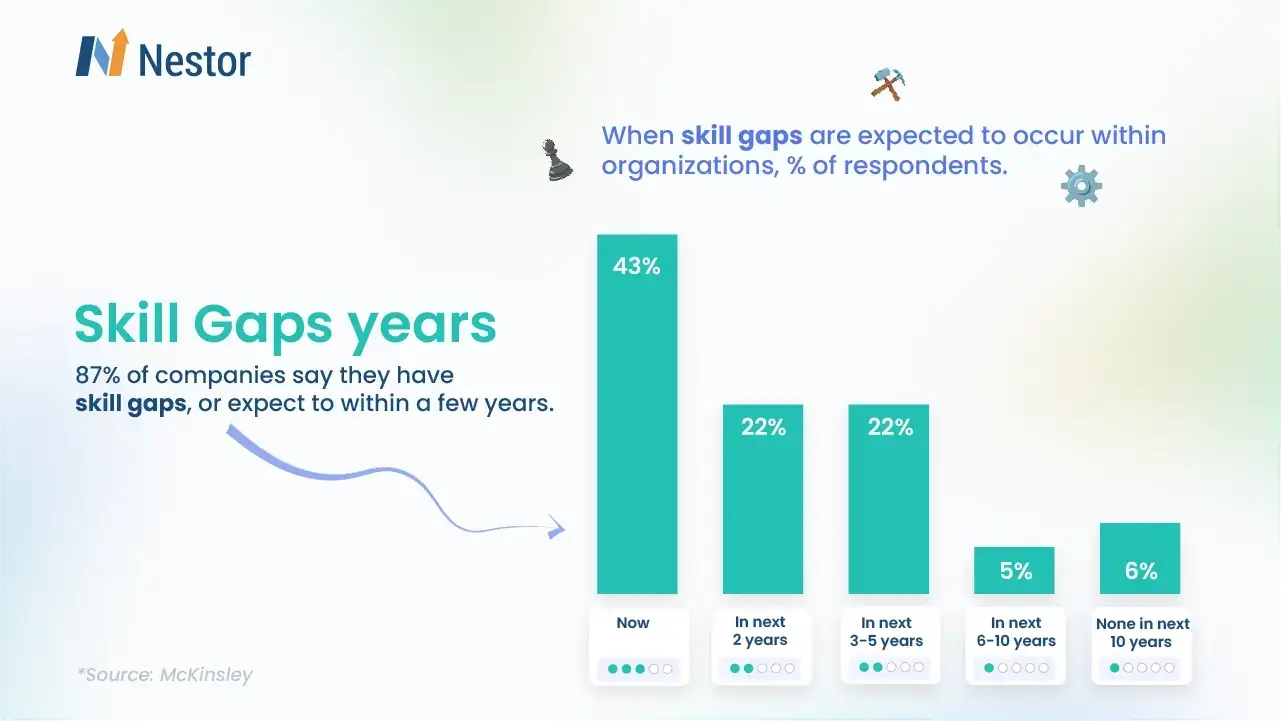
A thorough skills-gap analysis begins with these steps:
Establish your business objectives
Identify your short- and long-term goals. This process helps prioritize which skills are most important.
Ask yourself:
- What do we want to achieve in the next year? In the next 3-5 years?
- What markets do we want to enter or expand in?
- Are there new products or services we plan to launch?
- What technological changes do we expect in our industry?
Answering these questions builds a framework for identifying essential skills. In addition, these goals also guide employee development programs.
Involve your managers in the process
Your leadership and managers should understand your goals. This applies to all departments, including HR, Sales, Engineering, and Customer Support.
Involve them by:
- Organizing workshops to discuss business goals and their implications for each team.
- Asking managers to identify the most critical skills for achieving these goals.
- Encouraging open dialogue about current skill levels and gaps.
- Discussing how departmental needs might overlap or conflict.
Engaging managers provides a comprehensive view of your organization’s skill needs and ensures buy-in for development initiatives.
Define the skills required to achieve your objectives
To close the skills gap, identify the skills needed to meet your objectives. This process highlights where gaps exist and specifies the required competencies.
This step involves:
- Breaking down each goal into specific tasks and skills.
- Identifying both hard and soft skills needed for these tasks.
- Determining proficiency levels (basic, intermediate, advanced).
- Considering both current and future skill needs.
For example, if your goal is to boost sales in three years, your sales teams should excel in communication, negotiation, and persuasion.
Need help with skill mapping? Download our Skill Gap Analysis FREE Template. It is a powerful Google Sheets template that includes worksheets for every step of the skills gap analysis. Use Skills Required for The Role Worksheet to map skills by roles and set required proficiency levels.
Conduct skills assessments
Assessing the skills of your workforce helps evaluate current capabilities. Skills assessments can be done annually or periodically. These do not have to be rigid evaluations.
They can include:
- Formal tests or certifications.
- Performance evaluations with skills-based criteria.
- Project-based assessments.
- Peer reviews or 360-degree feedback.
- Self-assessments validated by managers.
Regular assessments help track progress and identify emerging gaps over time.
If you don’t know where to start and need support, our Skill Gap Analysis FREE Template offers you an easy-to-use worksheet designed for Individual Skills Self-Evaluation. Download it for free and invite your employees to reflect on their contribution, providing feedback on their achievements and challenges.
When conducting these assessments:
- Ensure they’re fair and consistent across all employees in similar roles.
- Focus on both technical skills and soft skills like communication, leadership, and problem-solving.
- Consider using external assessment tools or consultants for objectivity, especially for highly technical or specialized skills.
Provide employee self-assessment opportunities
Create a culture of trust. Employees should feel safe discussing their strengths and areas for improvement. Implement regular “skills check-ins” where employees can update their profiles and express their development goals.
Compare current skills with job descriptions and competency frameworks
Comparing existing skills with job requirements can highlight overlooked gaps. Since 58% of the workforce needs new skills to perform their jobs effectively, addressing these gaps is vital.
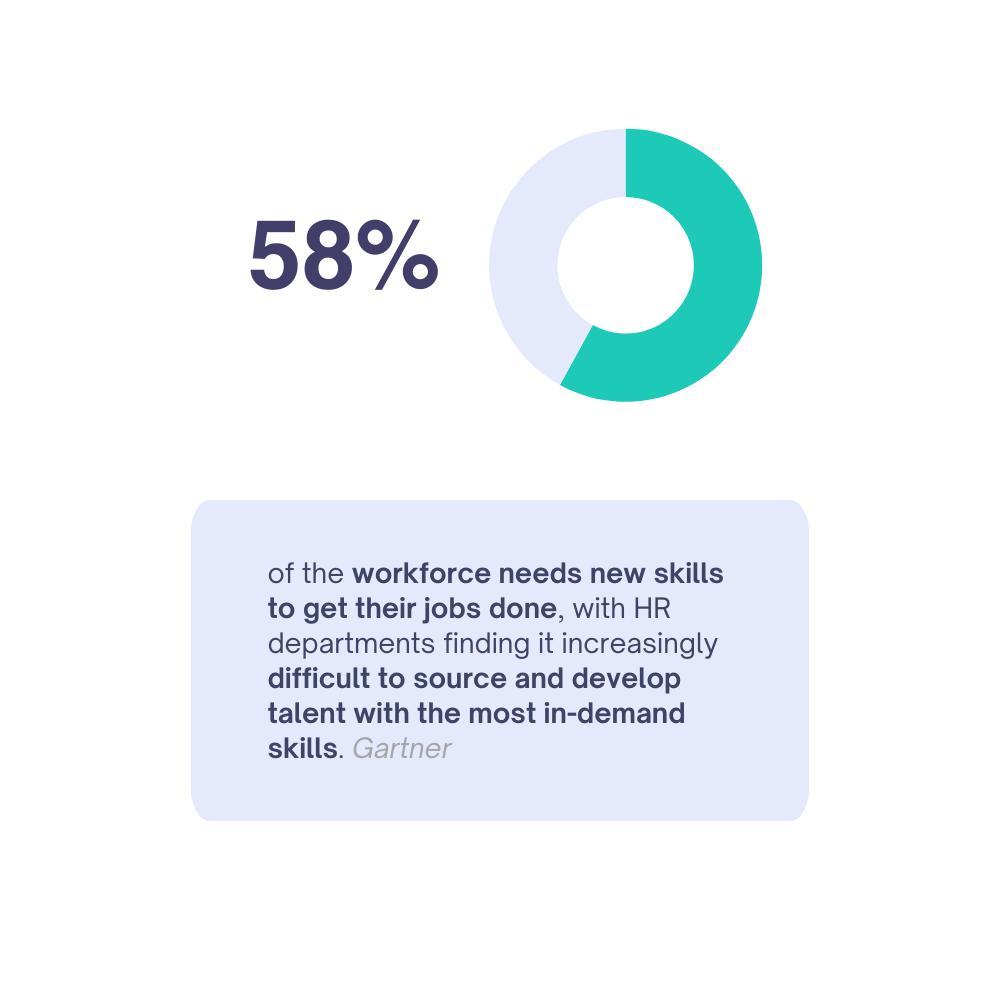
Do this:
- Review job descriptions for accuracy.
- Update competency frameworks to align with industry standards and business goals.
- Map employee skills assessments against these updated documents.
- Identify discrepancies and patterns that indicate systemic gaps.
This process helps pinpoint outdated skill requirements and refocus development efforts.
Don’t know how to approach this step? Our Skills Gap Analysis FREE Template gives you an easy start. It includes ready-made dedicated worksheets for both Individual Skills Assessments and Team Skill Inventory.
- Assess the gaps between the current state of employee competencies and what is necessary to achieve business goals.
- Analyze your existing talent pool, spot gaps and predict the company goals your people can achieve.
- Set time-framed development plans and continuously check the progress in how you manage to close the skills gap.
Make a copy of the Skills Gap Analysis FREE Template here and start now.
Stay updated on the latest industry trends
Identify emerging skills and knowledge gaps early on. This action helps you stay ahead of changes that may affect the company’s future. This doesn’t only apply to technological advancements, but also to regulatory changes and shifting market demands.
Pay special attention to emerging technologies, changing customer expectations, and shifts in regulatory environments that might require new skills in your workforce. In the current business landscape, the adoption of generative AI solutions is perhaps the best example.
Examine feedback from customers and clients
A less common but effective method to identify (potential) skills gaps gather feedback about your company, products, and services from your target audience or business partners.
Their insights could reveal opportunities for improvements or areas where your organization can make changes to grow even further. Here are some tips for this step:
- Review customer satisfaction surveys for comments about service quality or product knowledge.
- Analyze customer support tickets for recurring issues that might indicate skills gaps.
- Monitor social media and online reviews for mentions of areas where your team excels or falls short.
This external perspective can help you identify gaps in customer-facing skills as well as technical capabilities that impact product or service quality.
Look at competitors in your industry
Analyzing your competitors, as well as their skills and competencies, can help your organization identify where you are lagging behind or what you can do to be more competitive.
- Study their job postings to see what skills they’re prioritizing.
- Review their products or services for capabilities you might be lacking.
- Consider the skills of competitors who are particularly successful or innovative.
Remember, the goal isn’t to copy your competitors, but to understand the skills landscape in your industry and ensure you’re not falling behind in critical areas.
By thoroughly exploring these areas, you can understand your organization’s skills gaps. This knowledge will guide targeted training programs, strategic hiring, and initiatives to ensure your workforce has the skills needed to drive your business forward.
How to Close the Skills Gap in Your Organization
To close the skills gap you require a commitment at the leadership level. It demands a strategic approach and careful planning.
Reskilling current employees is often the most effective way to close the capability gap. About 53% of leaders prioritize reskilling employees, saving money and utilizing internal expertise.
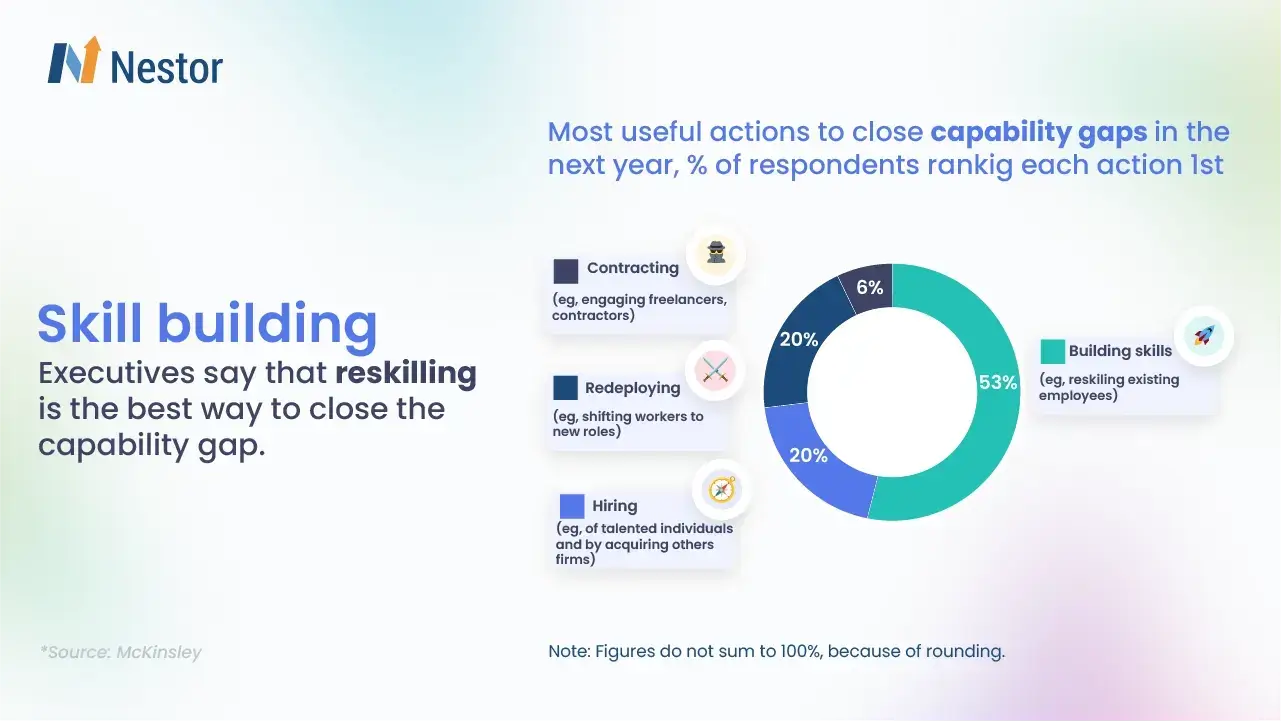
Some companies form a skills gap task force that includes members from various departments, like Learning & Development and talent acquisition. This team meets regularly to evaluate progress and make decisions.
The approach to closing skills gaps will vary based on your organization’s size, industry, and specific needs. What works for a tech startup may not suit a large manufacturing firm.
We know your time is valuable. If your primary goal is to close the skills gap, you can quickly navigate our Skills Gap Flowchart. This flowchart helps you understand the steps needed to achieve your goals. Answer the questions, follow the instructions, and dive deeper into the solutions in the sections below.
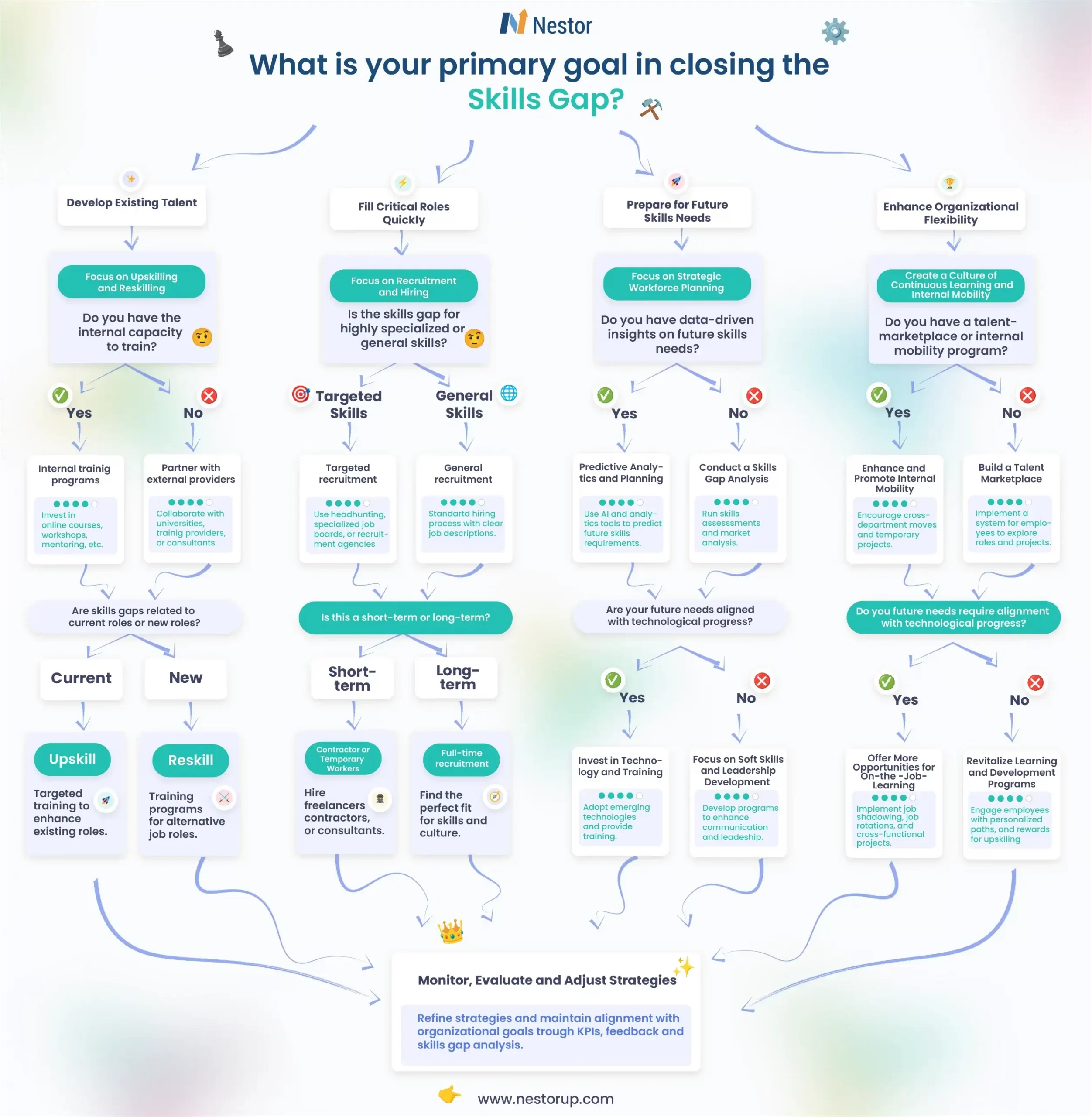
The following steps provide a solid foundation that can be adapted to meet your organization’s unique needs.
1. Develop a strategic upskilling/reskilling plan to close the skills gap
It’s hard to align organizational goals with employee development without a strategic plan. Start by using your skills gap analysis results. Focus on the best upskilling and reskilling programs for your workforce.
If your organization doesn’t track skills, start with our Skills Gap Analysis FREE Template. This template will help you through the process step by step.
Think about where your industry is going. What skills will be important in the next 5-10 years? By knowing the present and future direction, you can predict changes in the skills landscape. This helps you create proactive strategies to prevent skills gaps.
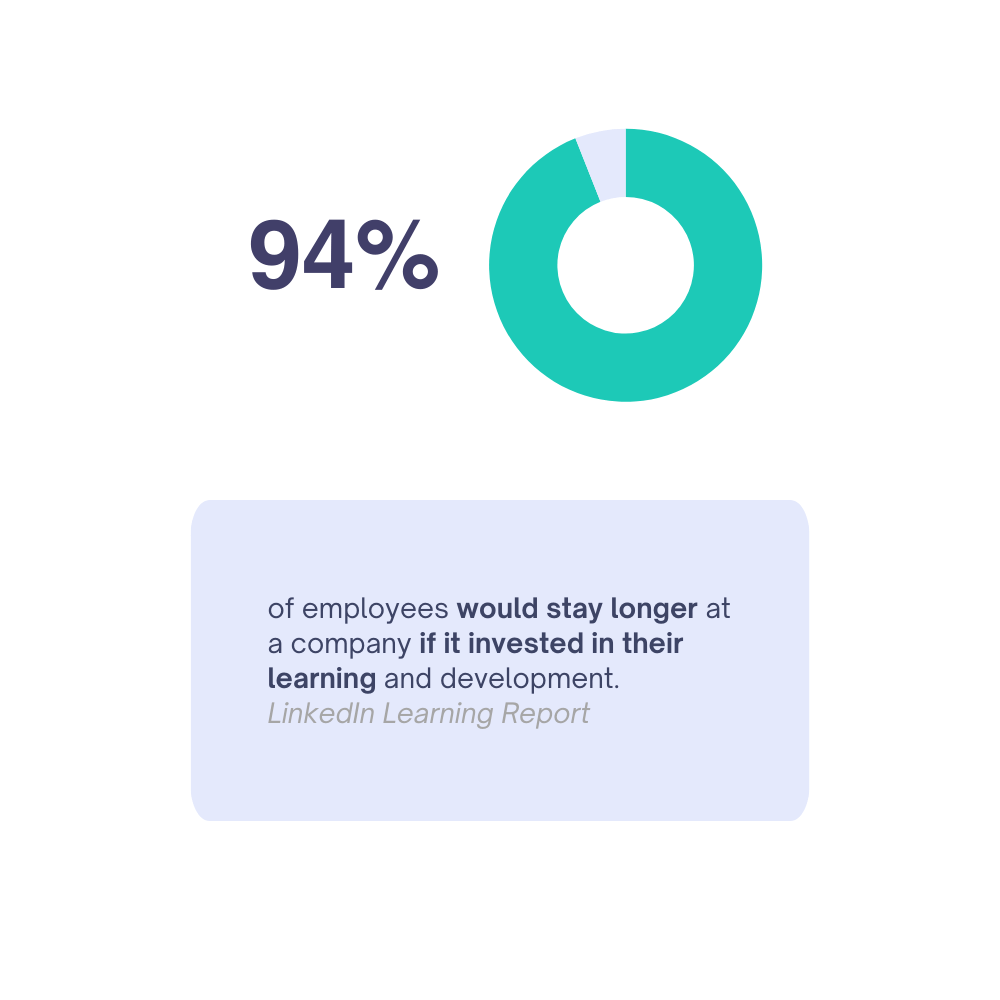
Research shows that 94% of employees would stay longer at a company ithat invests in their learning and development. If you want happier employees and better retention rates, you need a plan.
Your strategic plan should include internal factors, like training and succession planning, and external factors, like industry trends.
Your strategy should also have clear, measurable goals. For example, “Increase the number of employees skilled in data analysis by 30% within the next 12 months.” These goals help you track progress and show the return on investment of your skills development.
2. Create a culture of continuous learning to close the skills gap
Not all skills gaps will improve from a culture of continuous learning, but soft and digital skills certainly will.
These skills can develop during work (on-the-job learning). With the right support, it can become a regular initiative instead of an accidental one.
The benefits of this culture often appear during the skills gap analysis. Organizations may realize they do not fully know the skills their employees have.
3. Invest in employee training and development
74% of employees say they are not reaching their full potential because of a lack of development opportunities. Are you unsure if you’re focused on creating a learning-centered culture?
Cornerstone offers a free online self-assessment. This tool evaluates your talent program’s maturity level and provides resources for improvement.
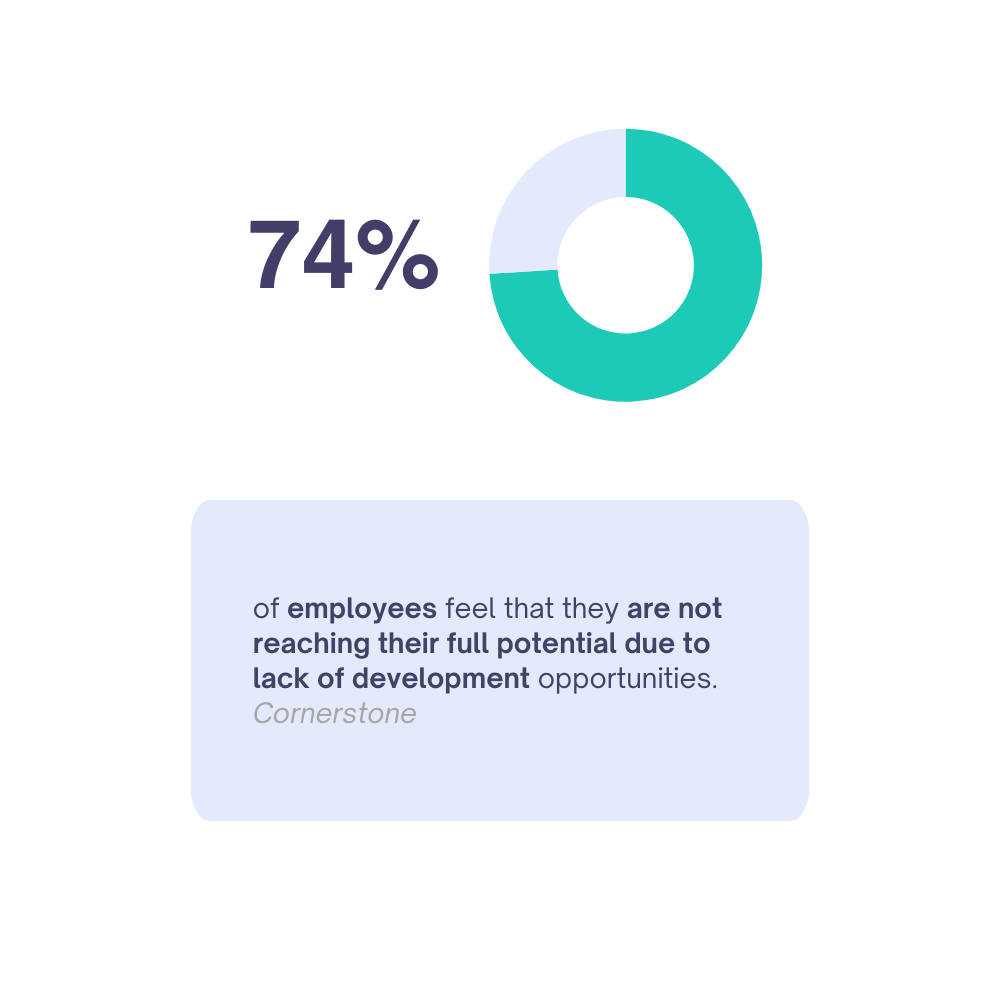
To close the skills gap, training, and development are essential. Not all skills gaps will benefit equally from learning initiatives. But, training is important for addressing many skill shortages.
Training can be formal or informal, organized internally or with third parties.
Today, there are many digital learning platforms with courses, training programs, workshops and masterclasses. Coursera, Udemy, edX are just a few options. Here’s a list of online learning platforms compiled by Forbes.
Training or development can take many forms:
- Job shadowing: Pair an employee with a more experienced colleague to learn from their work.
- Knowledge-sharing sessions: Regular sessions where employees share their expertise. These can be informal lunch-and-learn events or structured presentations.
- Mentorship programs: Pair less experienced employees with seasoned professionals for skill development and career guidance.
- Workshops: Hands-on sessions focused on specific skills. These are great for developing practical skills.
- Online courses: E-learning platforms make it easy to access courses on many topics. Partner with platforms like Coursera, Udemy, or LinkedIn Learning to offer various courses.
- Seminars and conferences: These events can provide valuable networking opportunities and expose employees to the latest industry trends.
- Job swapping or rotations: Allow employees to work in different roles to broaden their skills.
- Microlearning: Short, focused learning modules that employees can complete quickly. These are great for reinforcing knowledge.
- Virtual Reality (VR) and Augmented Reality (AR) training: These technologies provide immersive learning experiences.
- Gamification: Add game-like elements to learning to boost engagement and motivation.
The Skills Gap Analysis FREE Template can help you and your employees find development opportunities and create plans based on individual self-assessment and manager feedback.
4. Embrace experiential learning through internal mobility practices
Most learning occurs beyond formal training programs. Learning is a continuous process where people develop skills through on-the-job experiences. According to Center for Creative Leadership, 70% of learning is experiential and occurrs on the job. Another 20% comes from social interactions.

Learning happens when employees participate in various projects, cross-functional teams, or move vertically or laterally to other roles. A talent marketplace can greatly enhance internal mobility.
This platform makes all growth and advancement opportunities visible to employees.
A good talent marketplace helps democratize career development. It creates a more adaptable workforce. This way, organizations can quickly reallocate talent where it’s needed most, addressing skills gaps in real-time.
Learn more about Nestor’s talent and opportunity marketplace.
5. Monitor and evaluate skills development regularly to close the skills gap
If your organization has a skills gap task force, their main responsibilities include assessing current skill levels and tracking their development over time.
This evaluation must also check how effective training programs are. It should provide insights into what works and what doesn’t. Data-driven adjustments can then be made.
Here are some actions to take during this process:
- Establish baseline metrics: Measure current skill levels before starting any new initiatives
- Set clear, measurable goals: For example, “Increase the number of employees skilled in data visualization by 25% within 6 months.”
- Using a variety of assessment tools: This could include:
- Self-assessments
- Manager evaluations
- Practical skills tests
- Project outcomes
- Certifications earned
- Track individual progress: Monitor how employees are advancing towards their development goals. This could be part of regular performance reviews.
- Measure program effectiveness: Evaluate the impact of specific training programs. Are participants showing improved skills on the job?
- Monitor organizational impact: Look at broader metrics like productivity, innovation rates, or customer satisfaction.
- Produce regular reports: Compile findings into monthly, quarterly, or annual reports for leadership. Highlight progress, challenges, and recommendations.
The goal of monitoring and evaluation isn’t just to track progress. Use the insights gained to refine your approach to skills development.
6. Adopt emerging technologies and innovations early on
Companies that use new technologies in training are 3.5 times more likely to have highly engaged employees.
There are two main reasons to adopt the latest tools early:
- Digital tools, like skills management platforms and virtual training modules, can boost your training efforts.
- Quickly adopting innovative tools, like simulations or virtual reality, helps your workforce build needed skills faster.
7. Improve recruitment practices
A targeted recruitment process can help close the skills gap. Shift your focus from certifications and diplomas to real-life skills and experience. Prioritize practical skills and a desire to learn when selecting candidates.
Clearly outline expected skills in job advertisements. Focus on candidates’ current skills and their willingness to grow.
In addition, you can consider hiring temporary or contract workers to close the skills gap.
Include these external hires in training initiatives. This will help the rest of your workforce expand their skillset.
8. Collaborate with educational institutions
Companies are finding smart ways to recruit and prepare talent. For example, they can help shape curricula in universities or vocational schools with government approval. The goal is to align education with industry needs.
This type of initiative may be hard to implement. However, it can lead to positive results. It can reduce the resources needed to train graduates lacking real-world skills.
Examples of Common Skills Gaps
The mismatch between employees’ skills and required competencies can vary by industry. By 2025, 50% of all employees will need reskilling due to technological advancements.
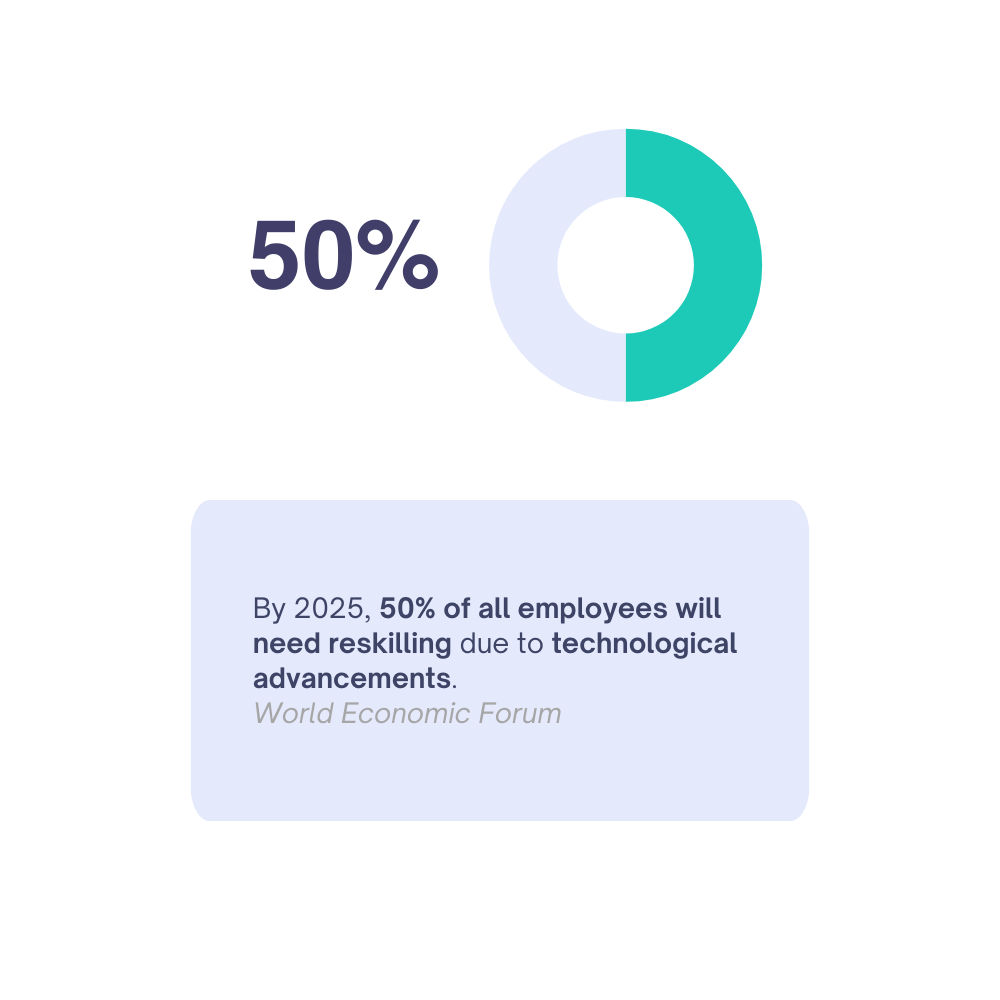
Certain areas have emerged, where these gaps are more common:
Digital skills gaps
As technology evolves, many workers struggle to keep their digital skills updated. Thus, companies need to invest in targeted training to address digital skills gaps.
Common digital skills gaps include:
- Artificial Intelligence (AI): Using AI tools to automate tasks.
- Cloud computing: Collaborating on online platforms.
- Cyber security: Identifying phishing emails and protecting sensitive information.
- Data analyzing: Extracting actionable insights from data.
- Social media marketing: Promoting products and engaging customers online.
Soft skills gaps
Gaps in interpersonal or soft skills can affect collaboration and productivity.
Common soft skills gaps include:
- Problem-solving: Analyzing issues and finding creative solutions.
- Teamwork or collaboration: Working effectively with others.
- Communication: Clearly expressing ideas to different audiences.
- Leadership: Inspiring and motivating teams.
Hard skills gaps
Hard skills can overlap with digital skills.
Common hard skills gaps include:
- Automotive servicing: Evaluating and servicing vehicles.
- Foreign languages: Mastering multiple languages can help employees stand out.
- Graphic design & video editing: High-quality design and video are needed for online presence.
- Programming: Knowledge of multiple programming languages is highly sought after.
- SEO: Optimizing content for search engines is essential.
If you want a quick tool to identify and close skills gaps, download the Skills Gap Analysis FREE Template. This tool is a great start and can save time in the process.
As your team grows, managing skills gaps manually can become overwhelming. Hours spent on spreadsheets can lead to missed insights and less time for strategic decisions. Many HR leaders and managers face this
Thus, if at any point you feel stuck in spreadsheet mode, we’re here to help!
How can Nestor help you identify and close the skills gap in your organization?
With Nestor’s AI-powered platform, you can go beyond the manual processes to close the skills gap and let our system handle the heavy lifting for you.
- Map skills and close gaps in real-time:
- Free yourself from repetitive, manual processes with our automated skills gap analysis
- Get insights into future skills needs
- Instantly visualize skill gaps, track employee development, and receive suggestions on bridging them
- Become a strategic leader with workforce analytics
- Forecast future skill needs confidently and stay ahead of the competition.
With a market library of over 20,000 skills enhanced by Nestor’s AI skills suggestions, you gain unprecedented visibility into your people’s capabilities and dynamic mapping of their skills.
With Nestor, you can also:
- Identify evolving skill needs
- Track and evaluate skill levels
- Match skill supply and demand
- Develop and grow organizational & people capabilities
- Enable internal mobility and talent optimization
Together, we’ll unleash the full potential of your talented workforce. If you want to learn more about how Nestor can help you, schedule a free demo session.
Frequently Asked Questions (FAQ) on How to Close the Skills Gap
What are some strategies used to close the skills gap?
Key strategies include:
- Developing a strategic upskilling/reskilling plan aligned with company goals.
- Creating a culture of continuous learning to encourage on-the-job learning and skills development.
- Partnering with educational institutions to ensure access to new talent with relevant skills.
- Using technology to enhance training and track progress.
How can a skills gap task force help to close the skills gap?
Creating a dedicated skills gap task force can bring together employees from various departments. L&D, talent acquisition, and department leaders can regularly evaluate progress. They can make decisions, and ensure that the organization remains aligned with its skills development goals.
How can reskilling employees help close the skills gap?
Reskilling existing employees is a cost-effective way to address skills shortages. Reskilling allows businesses to leverage internal expertise. As a result, they save time and money on recruitment.
What industries are most affected by skills gaps?
Industries undergoing rapid change, such as technology, healthcare, finance, and renewable energy, are particularly affected by skills gaps. In these sectors, regulations and technologies evolve quickly, and employees need continuous training to keep up.
Can closing the skills gap improve employee retention?
Yes. Providing employees with opportunities for growth and development can increase job satisfaction, reduce turnover, and improve retention. When employees see that their company is invested in their future, they’re more likely to stay and contribute long-term.







